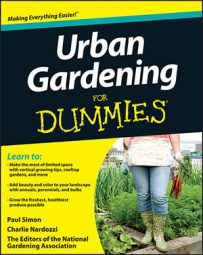The soil is the heart of your urban farm, and organic matter is the soul of your soil. Organic matter in the soil is miraculous stuff. It can take a sandy, lifeless soil and make it teem with vitality again. It can take a rock-hard, clay soil and open it up into a loose, easy-to-work, fertile material.
Although it’s a great addition to any soil, organic matter is a particularly important addition to soils that you till or turn over a lot, such as the soil in a vegetable or annual flower garden.
As oxygen is introduced into the soil during the tilling process, the soil microbes go wild on the organic matter, eating it up fast. As those microbes die off, the soil gets a temporary boost in nutrients; however, the overall organic matter content of the soil decreases over the long term. So adding organic matter is especially critical in these heavily used soils.
Organic matter comes in many forms, and each form has its own ideal uses. Some are more readily available to the urban gardener than others. Here are some of the more common types of plant-based organic matter you can use in your garden:
Leaves: This form of organic matter is the one that most city gardeners have easy access to. Adding green leaves to your garden gives plants a rich source of nitrogen, but adding primarily dried leaves is best because they are widely available in fall for the raking. Try to gather leaves that are not close to busy streets, where particulate air pollution may be accumulating on them.
Grass clippings: Although many urban gardeners don’t have large lawns, any amount of grass clippings can be helpful to your soil. Just make sure you use only grass clippings from lawns that haven’t been treated with chemical herbicides; the residues from the chemicals may adversely affect your plants.
If you don’t have much grass of your own, contact a lawn service in your neighborhood to see what it does with its grass clippings. If they’re untreated, you may be able to get more than you need to mulch your garden and build you soil.
Pine needles: Pine needles may be available for the taking in your urban area. Keep in mind, however, that they’re naturally acidic, so use them only on plants such as blueberries and rhododendrons that like an acidic soil pH.
Wood chips: Wood chips, sawdust, and bark mulch are great materials to use around trees, shrubs, and perennial plants. They take a long time to break down and feed the soil and provide an insulating layer for these long-lived plants.
Contact a city arborist or local tree surgeon to see whether they have wood chips you can have. Be sure to ask before you get the chips whether the trees they came from had any insect or disease problems so you don’t introduce a pest problem into your garden.
Hay and straw: Most urban areas don’t have ready access to hay and straw, and they can be expensive to purchase. But if you can afford them (or if you have a farm connection), they can be great additions to your garden. Both of these dried grasses take a growing season to break down, so they make for good mulches around annual plants and in pathways.
One thing to keep in mind is that hay (although much widely available and cheaper than straw) tends to have weed seeds in it, while straw doesn’t.

